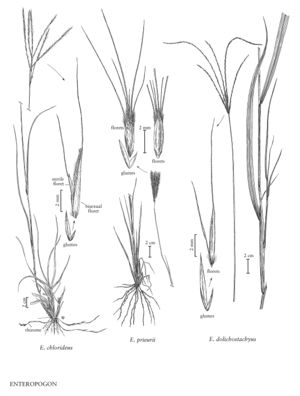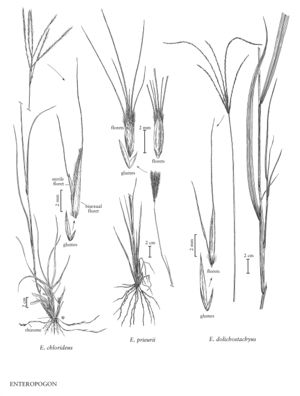Plants annual or perennial; cespitose, sometimes stoloniferous or rhizomatous. Culms to 120 cm, not woody. Sheaths open; ligules membranous, ciliate; blades flat. Inflorescences terminal, panicles of 1-20 non-disarticulating, spikelike branches, exceeding the upper leaves; branches digitately or racemosely arranged, if racemose, the lower nodes usually with more than 1 branch. Spikelets solitary, strongly imbricate, appressed to somewhat divergent, dorsally compressed, with 2-6 florets, lowest floret bisexual, elongate, remaining florets progressively reduced, usually the distal florets rudimentary and sterile, occasionally staminate; disarticulation beneath the glumes. Glumes unequal, subulate to lanceolate, membranous; upper glumes much shorter than the lowest florets, acute or shortly awned; calluses strigose; lowest lemmas stiff, 3-veined, ridged over the midveins, apices acute or bidentate, usually awned from between the teeth, without lateral awns; paleas almost as long as the lemmas, 2-keeled and bidentate; distal lemmas awned; lodicules 2; anthers 1-3. Caryopses sulcate; embryos 1/4 - 1/3 (1/2) as long as the caryopses. x = 10.
Distribution
N.C., Ariz., Ala., Tex.
Discussion
Enteropogon is a tropical genus of 17 species. Anderson (1974) included it in Chloris, but it is now usually recognized as a separate genus. It differs from Chloris in its dorsally compressed, indurate lemmas that are conspicuously ridged over the midvein. The caryopses also differ, being dorsally flattened with a shallow ventral groove in Enteropogon; in Chloris, the caryopses are basically triangular in cross section although there may be a shallow ventral groove. The embryos also tend to be shorter relative to the caryopses in Enteropogon than in Chloris, but there is some overlap.
There is one species native to the Flora region; two others have been found at various locations but have not persisted.
Selected References
Key
| 1 | Panicles with 3-15 branches racemosely arranged; plants rhizomatous | Enteropogon chlorideus |
| 1 | Panicles with 1-10 branches in a single, digitate cluster; plants not rhizomatous, sometimes stoloniferous. 2. Panicle branches 6-11 cm long, erect to slightly diverging; spikelets with 5-6 florets, the distal 4-5 sterile; plants stoloniferous | Enteropogon prieurii |
| 2 | Panicle branches 7-25 cm long, divergent to drooping; spikelets with 2 florets, the distal floret sterile; plants not stoloniferous | Enteropogon dolichostachyus |
"decumbent" is not a number.

